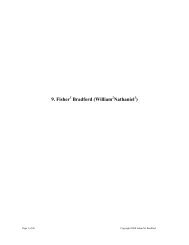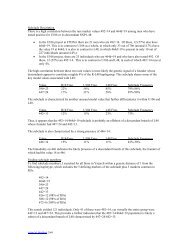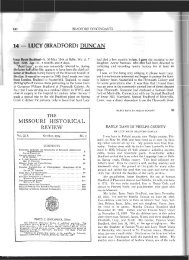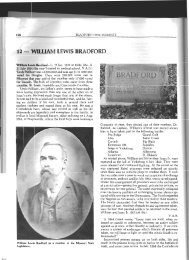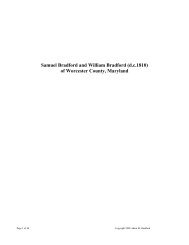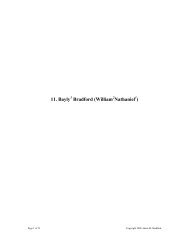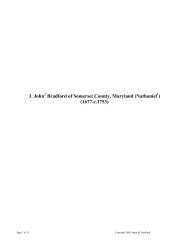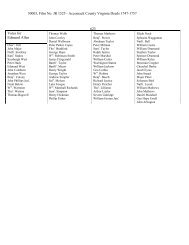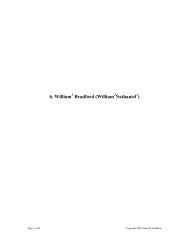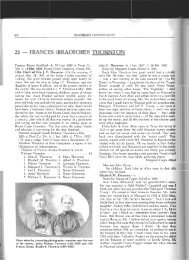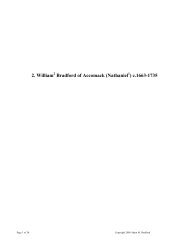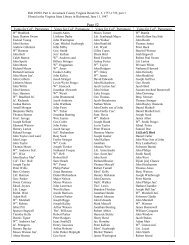1. Nathaniel Bradford of Accomack County, Virginia - Lower ...
1. Nathaniel Bradford of Accomack County, Virginia - Lower ...
1. Nathaniel Bradford of Accomack County, Virginia - Lower ...
You also want an ePaper? Increase the reach of your titles
YUMPU automatically turns print PDFs into web optimized ePapers that Google loves.
natives. This doesn’t change the fact that such actions as men like Scarburgh took would continue to occur,<br />
but it shows that a distinction ought to be drawn between those Englishmen who wished violence upon the<br />
Indians and those who wished to find some way to share the same space. However, this should not discount<br />
what happened to the Indians <strong>of</strong> <strong>Accomack</strong> over the course <strong>of</strong> the 17 th century. By the end <strong>of</strong> <strong>Nathaniel</strong>’s<br />
life they were not only in a position <strong>of</strong> complete dependence upon the English, but their population had<br />
been decimated. Only a tiny portion <strong>of</strong> this loss <strong>of</strong> population was likely attributed to the violent actions <strong>of</strong><br />
Scarburgh and others. Much <strong>of</strong> it was due to disease. In particular, the smallpox epidemic <strong>of</strong> 1667 affected<br />
the Indians far more severely than it did the English, carrying <strong>of</strong>f hundreds out <strong>of</strong> a total population that<br />
before the arrival <strong>of</strong> the English was probably only about 2000 and must have been even less at the<br />
outbreak <strong>of</strong> the disease. 136 By 1705 the list <strong>of</strong> surviving tribes was painfully small. 137 Indians were still<br />
living in their ancient homes at Wachapreague and other places in <strong>Accomack</strong>, but only by the sufferance <strong>of</strong><br />
the English. Some tribes had disappeared completely or had been incorporated into other tribes. In time the<br />
same fate would befall the remainder.<br />
* * * * *<br />
Charles Holden<br />
Both the simple outline first drawn <strong>of</strong> <strong>Nathaniel</strong>’s family and the picture just sketched <strong>of</strong> the makeup <strong>of</strong> his<br />
household are significantly complicated by an order from the 16 August 1667 court <strong>of</strong> <strong>Accomack</strong>, in which<br />
reference is made to <strong>Nathaniel</strong>’s prosecution <strong>of</strong> Charles Holden, a young attorney and later a deputy<br />
attorney general <strong>of</strong> the Eastern Shore. On this occasion, <strong>Nathaniel</strong> attempted unsuccessfully to force<br />
Holden to support a child <strong>Nathaniel</strong>’s wife bore six months into their marriage. As neither the name <strong>of</strong><br />
<strong>Nathaniel</strong>’s wife nor the name <strong>of</strong> the child is given in the court order, the question <strong>of</strong> their identity is a<br />
matter for investigation. While analysis <strong>of</strong> the record yields inconclusive results, it opens up an intriguing<br />
possibility - that <strong>Nathaniel</strong> may have had a third wife, no direct record <strong>of</strong> whom exists.<br />
“Whereas <strong>Nathaniel</strong> <strong>Bradford</strong> prosecuted Charles Holden and pleaded before ye Court that for so<br />
much as ye now wife <strong>of</strong> ye said <strong>Nathaniel</strong>l <strong>Bradford</strong> hath had a Child wthin six months after<br />
mariage and doth affirm Charles Holden to bee father desiring ye sd Holden might keepe ye sd<br />
Child according to Act <strong>of</strong> Assembly The Court Examining ye cause finds noe such rule by Act <strong>of</strong><br />
Assembly to inforce the said Holden to keepe ye sd Child. Therefore dismisd the suit. 138<br />
At first glance, Alice would seem to be the obvious candidate for <strong>Nathaniel</strong>’s wife in 1667. There is no<br />
record <strong>of</strong> any other wife <strong>of</strong> his between Alice Smith and Joan Franklin, and it can’t be said for certain that<br />
<strong>Nathaniel</strong> was married to Joan until 1677, a full ten years after the Charles Holden prosecution. By the<br />
same token, it is known that Alice was alive three years before this prosecution. If the wife in question is<br />
indeed Alice, then the possibility arises that <strong>Nathaniel</strong>, Jr.’s natural father was Charles Holden. It depends<br />
on whether or not <strong>Nathaniel</strong>, Jr. was Alice’s first child. In fact, this seems likely. In 1664, when <strong>Nathaniel</strong><br />
and Alice sold the land inherited from Alice’s father, the elder <strong>Nathaniel</strong> was obliged to provide for Alice’s<br />
heirs, as stipulated in Richard Smith’s will. Yet he provided only for <strong>Nathaniel</strong>, Jr. and no other child <strong>of</strong><br />
Alice’s, which indicates that <strong>Nathaniel</strong>, Jr. had no older siblings. Therefore, if the wife in question in the<br />
Holden prosecution was Alice, then the child fathered by Charles Holden was probably <strong>Nathaniel</strong>, Jr. 139<br />
However, several considerations cast doubt on the conclusion that Alice was the wife referred to in the<br />
Holden prosecution. First, in 1664, when he granted his son land in lieu <strong>of</strong> the Richard Smith inheritance,<br />
<strong>Nathaniel</strong> Sr. referred to <strong>Nathaniel</strong> Jr. as “my heir”, implying that he reckoned him his own son. If another<br />
Page 26 <strong>of</strong> 74 Copyright 2008 Adam M. <strong>Bradford</strong>




